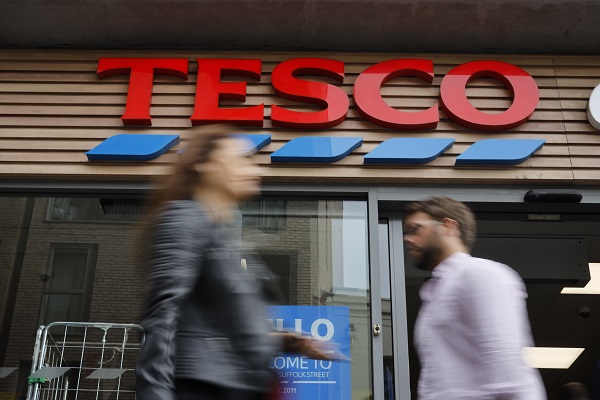This is what just sent Tesco shares to six-month low
13th April 2022 08:07
by Richard Hunter from interactive investor
The UK's biggest supermarket had a strong year, but something it said has rattled investors. Our head of markets explains what went right and what went wrong over the past 12 months.

Tesco (LSE:TSCO) is seeing its ambitious plans coming together, in another example of a company which used the pandemic to accelerate a corporate turnaround.
The key metrics are testament to the success of the strategy and on most fronts have comfortably exceeded expectations in these annual results. Adjusted operating profit of £2.83 billion for the 52 weeks ended 26 February 2022 is 58% higher than the previous year, with pre-tax profit topping £2 billion and representing an increase of 220%.
Importantly, given the business in which it operates, Tesco has seen a significant improvement to both its value perception and quality perception. It has racked up the points as its aggressive schemes such as Aldi price match, coupled with growth in its offerings such as Clubcard and Low Everyday prices, have seen its market share grow to a level not seen in several years, and one which retains its dominant UK position.
- The Week Ahead: US banks, interest rates, easyJet, Tesco
- Best stocks to own during the last tax year
- Why I’m worried about Tesco’s share price
A number of factors have combined to give Tesco a strong tailwind during this trading year. Lower Covid-related costs and the absence of UK pension contributions following the lump sum payment after the sale of the Asian unit, have boosted cashflow. At the same time, the virtuous circle of lower prices leading to higher market share, revenues and profits has also resulted in a strong capital position.
Quite apart from reducing net debt by 12% over the period, Tesco has committed to a further share buyback programme of £750 million and has increased the dividend to a level which projects a yield of 4%. Not only do these shareholder returns signal the company’s confidence in prospects, but shareholders are also being provided with a generous rate of return, especially in this historically low interest rate environment.
The online business which was turbocharged both in terms of investment and returns during the pandemic continues to be an important strand within the overall offering, fulfilling 1.2 million orders per week and seeing an increase of 1.4% in market share to stand at 34.8%.
Alongside some new initiatives such as the “Whoosh” offering, the pressure will remain on rivals, while the revival of fortunes also continues elsewhere within the group. The reopening of hospitality outlets has boosted the contribution of Booker, with Tesco Bank swinging to an adjusted operating profit of £176 million from a loss of £175 million the previous year, as the monies set aside for bad debts did not materialise.
- Rolls-Royce shares dealt hammer blow, but all systems go for BAE
- Stockwatch: long-term value vs near-term risk
- Chart of the week: latest share price forecast for Lloyds Bank
After a successful Christmas trading season and being in a position to offer multi-channel options to the customer, normalising consumer habits post-pandemic are simply switching customer numbers between its lines rather than resulting in a loss of business to rivals. This could become something of a double-edged sword, however – the level of investment required to maintain its current position will be significant, especially with regard to its pricing position.
At the same time, the company is far from immune to rising cost inflation, and is also aware of the importance of value to a consumer who is becoming increasingly squeezed as day-to-day budgets come under pressure from a cost of living crisis. Inflation on the whole is a pressing global issue, although as a supermarket Tesco does retain an element of being a defensive stock, given the need for its products regardless of the wider economic backdrop.
Overall, however, Tesco is a force to be reckoned with in its industry, and is showing few signs of taking its foot off the pedal to keep its rivals at bay.
Despite a modestly disappointing share price performance given wider consumer spending concerns of late, over the last year the shares have managed to post an impressive gain of 17%, as compared to a hike of 10% for the wider FTSE100.
Profit warning
The weaker share price reaction in early exchanges relates to the company projecting a lower retail profit given the need for further investment and the impact of inflationary pressures.
Tesco now expects retail adjusted operating profit of between £2.4 billion and £2.6 billion in the 2022/23 financial year. Last year it was £2.65 billion following a 35.8% increase at constant exchange rates.
Even so, the market consensus of the shares remains at a "strong buy", reflecting the generally held view that there is still much to go for from an investment perspective.
These articles are provided for information purposes only. Occasionally, an opinion about whether to buy or sell a specific investment may be provided by third parties. The content is not intended to be a personal recommendation to buy or sell any financial instrument or product, or to adopt any investment strategy as it is not provided based on an assessment of your investing knowledge and experience, your financial situation or your investment objectives. The value of your investments, and the income derived from them, may go down as well as up. You may not get back all the money that you invest. The investments referred to in this article may not be suitable for all investors, and if in doubt, an investor should seek advice from a qualified investment adviser.
Full performance can be found on the company or index summary page on the interactive investor website. Simply click on the company's or index name highlighted in the article.